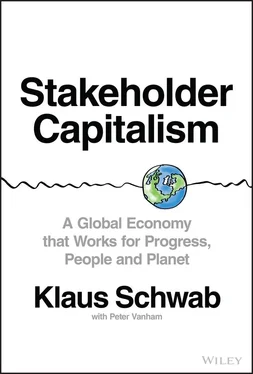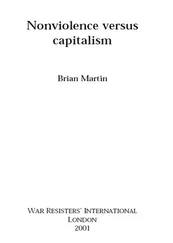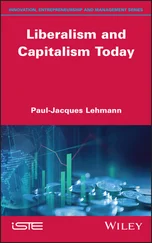Klaus Schwab - Stakeholder Capitalism
Здесь есть возможность читать онлайн «Klaus Schwab - Stakeholder Capitalism» — ознакомительный отрывок электронной книги совершенно бесплатно, а после прочтения отрывка купить полную версию. В некоторых случаях можно слушать аудио, скачать через торрент в формате fb2 и присутствует краткое содержание. ISBN: , Жанр: economics, на английском языке. Описание произведения, (предисловие) а так же отзывы посетителей доступны на портале библиотеки ЛибКат.
- Название:Stakeholder Capitalism
- Автор:
- Жанр:
- Год:неизвестен
- ISBN:9781119756149
- Рейтинг книги:4 / 5. Голосов: 1
-
Избранное:Добавить в избранное
- Отзывы:
-
Ваша оценка:
- 80
- 1
- 2
- 3
- 4
- 5
Stakeholder Capitalism: краткое содержание, описание и аннотация
Предлагаем к чтению аннотацию, описание, краткое содержание или предисловие (зависит от того, что написал сам автор книги «Stakeholder Capitalism»). Если вы не нашли необходимую информацию о книге — напишите в комментариях, мы постараемся отыскать её.
Individual agency:
A clearly defined social contract:
Planning for future generations:
Better measures of economic success: Stakeholder Capitalism: A Global Economy that Works for Progress, People and Planet
Stakeholder Capitalism
Stakeholder Capitalism — читать онлайн ознакомительный отрывок
Ниже представлен текст книги, разбитый по страницам. Система сохранения места последней прочитанной страницы, позволяет с удобством читать онлайн бесплатно книгу «Stakeholder Capitalism», без необходимости каждый раз заново искать на чём Вы остановились. Поставьте закладку, и сможете в любой момент перейти на страницу, на которой закончили чтение.
Интервал:
Закладка:
We did not listen to Simon Kuznets’ cautious warnings: he told us GDP was a poor measure for broad societal progress, as it was more geared toward measuring production capacity than any other signs of prosperity. He wasn't convinced that the declining income inequality during the 1950s would be a permanent feature but rather saw it as a temporary effect of the specific technological advances that favored inclusive growth at the time. And he never subscribed to the notion of any “Environmental Kuznets’ Curve,” which hypothesized that harm to the environment would decline as an economy developed. We are now paying the price for it.
But before we try to make up for those errors in our economic development though, we must first ask: Is another development path already available? And to what extent can it be found in the East, in the rise of Asia?
3
The Rise of Asia
The view from the Sham Chun River in Southern China offers a stark contrast. On its southern bank, rice paddies stretch almost as far as the eye can see. On its northern bank, skyscrapers dominate the skyline.
It wasn't always so. Forty years ago, there was almost nothing on either side of the river. The most developed part was on the southern banks, where the city of Hong Kong was a few miles out. Train tracks connected the British-ruled “Northern territories” with the empty Chinese mainland across the river. A lone Chinese guard would inspect the river's crossing point.
Four decades later, the contrast isn't one a visitor from the past might have expected. The rice paddies to the south still belong to Hong Kong, the long-time financial capital of Asia. But the skyscrapers to the north are now part of contemporary China's technology capital, Shenzhen, a city that appeared out of nowhere.
What happened north of the Sham Chun River in those 40 years, represents perhaps the greatest economic miracle ever. In 1979, those living there had an average income of less than a dollar a day. Today, Shenzhen has a per capita GDP of almost US$30,000, about a 100-fold increase over 1979. It is home to tech giants such as Huawei, Tencent, and ZTE, 114and a “maker movement” of tech start-ups. Hong Kong didn't stand still either, but it now has a formidable twin next door.
How did this turnaround happen? And what does it tell us about the broader shift of the world economy to the East?
China's Special Economic Zones
I first visited China in April 1979. The country's new leader Deng Xiaoping had only been in power for about a year, and the land I encountered was still deeply impoverished. China had suffered for a long period from foreign invasions, civil war, and policies that had failed to deliver any meaningful economic progress.
That detrimental situation had been 150 years in the making. For much of the past millennia, China had been an economic superpower, alongside India, but things changed during the 19th century. First, there was a so-called Chinese Century of Humiliation from about 1840 onward. During this period, the proud and powerful Chinese civilization was defeated in various Opium Wars with Britain. It also ceded key Chinese ports and cities and territory in Indochina to Britain, France, and Japan, and suffered from Japanese occupation during the Second World War. A key reason for these defeats was that the Industrial Revolution had not spread in China, giving its adversaries economic, military, and technical supremacy.
The turmoil also led to the fall of the established political regime. The Qing Imperial dynasty was overthrown in 1912. After that, various political groups vied for power for several decades, all through the Japanese occupation in the 1930s and 1940s, and until after the end of the Second World War. Initially, the Nationalist Party of Chiang Kai-shek prevailed. He led a national government in China in the first few years after the Japanese occupation had ended. But it was unable to fully gain control over the chaotic situation that resulted after the retreat of Japanese troops and faced strong internal opposition. Instead, the civil war continued, and ultimately, the Nationalists were defeated by Mao's Communist Party.
Under the leadership of Chairman Mao, from 1949 to 1975, the Communist Party of China (CPC) became the lone governing party of the country, ending the political turmoil more decidedly. The CPC founded the People's Republic of China as a single-party state, which brought stability to the regime for the price of democratic freedom.
On the social and economic front, the People's Republic in its early years did not manage to bring about the progress enjoyed in other regions, including the United States, Western Europe, and the Soviet Union. The country reverted to autarky in terms of food production, central planning for its industrial production, and severe restrictions in terms of political and cultural freedoms. By the late 1970s, when Deng Xiaoping came to power as successor of Mao, the Chinese economy was a shadow of its former self. The Middle Kingdom (as China is sometimes called) had become a developing country, and many of its people lived below the poverty line.
Deng wanted to change that, and in 1978, he visited Singapore. At the time, the island city-state was one of the four so-called Asian Tigers (Hong Kong, Taiwan, Singapore, and South Korea), economies that saw a rapid development in the 1960s and 1970s based on foreign direct investments (FDI), the shielding of key industries from foreign competition, and export-led growth. Having been inspired by the city-state's example, he pursued a new economic development model for China as well: the Reform and Opening-Up, starting in 1979. The kernel of the economic turnaround in this model lay in attracting FDI from some of China's neighbors, including Hong Kong, and allowing these investors to set up businesses in Special Economic Zones (SEZs) on various stretches along the populous Guangdong (Canton) coastline in Southern China. Shenzhen, north of the Sham Chun River, was one of them.
The SEZs were a sandbox for private business to operate in China. Elsewhere in the country, rules on private ownership, incorporation, and profits remained restricted for another number of years. China was a communist country after all. But in the SEZs, foreign investors could set up a business (provided it was aimed at exporting), own or at least lease property, and enjoy special legal and tax treatments.
The goal, researcher Liu Guohong of Shenzhen-based China Development Institute told us in 2019, 115was to give China a taste of a “market-oriented economy” (Deng would call it “socialism with Chinese characteristics,” and his successor Jiang Zemin talked of a “socialist market economy”). But there was virtually no money to develop any economic activity, so having SEZs close to Hong Kong—with its broad pool of money and manufacturing—was the next best option.
The bold plan worked. In 1982, Nanyang Commercial Bank, a Hong Kong–based financial institution started by a Chinese immigrant, set up a branch in Shenzhen, just a few miles north of Hong Kong. It was the first commercial bank in mainland China, 116and its arrival marked a watershed moment in the development of the country. The Hong Kong bank set up a cross-border loan to its Chinese affiliate. It allowed the Shenzhen branch to finance long-term leases of land and the opening of factories in Shenzhen.
The Shenzhen authorities also did their part. Previously, land in China was solely state-owned, meaning it could not be accessed by private investors. Now, Shenzhen allowed foreign investors to use land for commercial and industrial purposes. In 1987 the Shenzhen SEZ even organized a public land auction, the first in China since the foundation of the People's Republic in 1949. 117
Читать дальшеИнтервал:
Закладка:
Похожие книги на «Stakeholder Capitalism»
Представляем Вашему вниманию похожие книги на «Stakeholder Capitalism» списком для выбора. Мы отобрали схожую по названию и смыслу литературу в надежде предоставить читателям больше вариантов отыскать новые, интересные, ещё непрочитанные произведения.
Обсуждение, отзывы о книге «Stakeholder Capitalism» и просто собственные мнения читателей. Оставьте ваши комментарии, напишите, что Вы думаете о произведении, его смысле или главных героях. Укажите что конкретно понравилось, а что нет, и почему Вы так считаете.












